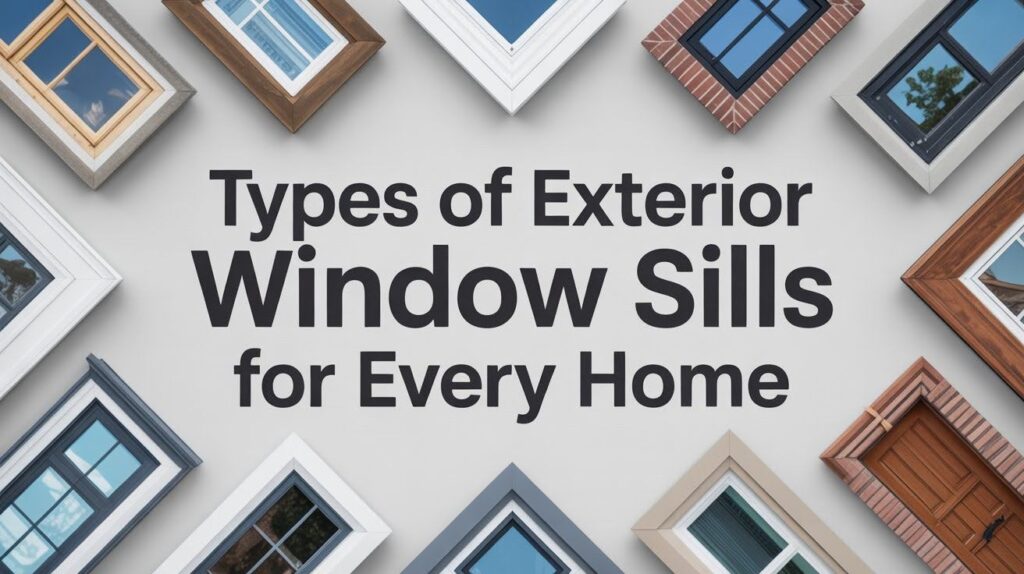Choosing the right window sill protects your home from water damage. I’ve worked with homeowners who learned this lesson the hard way. Cheap or wrong sills let moisture seep into walls, causing rot and costly repairs.
This guide covers types of exterior window sills that work for different homes. You’ll learn about wood, stone, metal, and synthetic options.
I’ll explain which materials suit your climate and budget. You’ll also find maintenance tips to keep your sills lasting longer.
By the end, you’ll know exactly which sill type fits your needs. Let me help you make a smart choice that protects your investment.
What to Consider Before Choosing an Exterior Window Sill
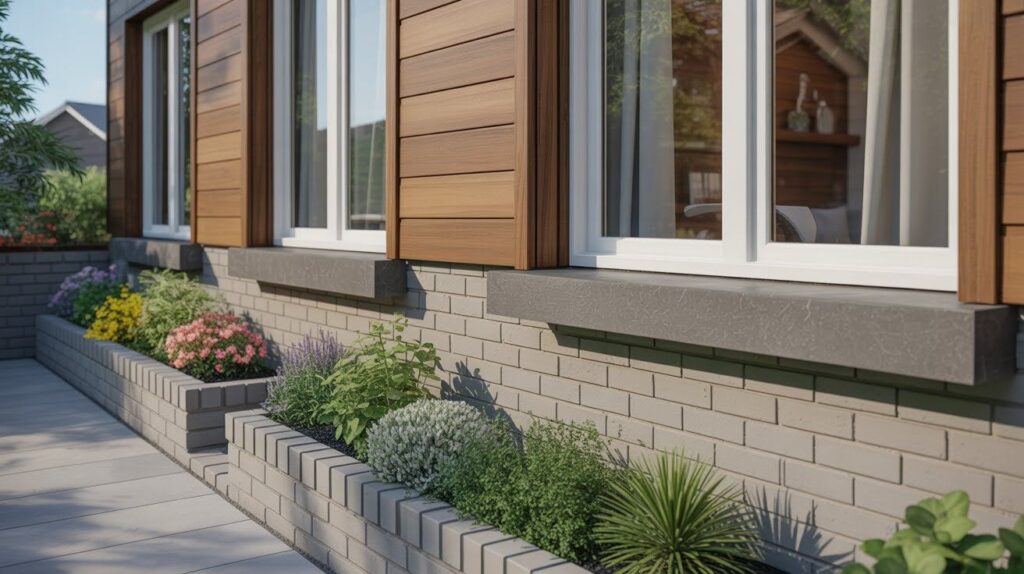
Picking the right window sill takes planning. Consider your climate, home style, maintenance needs, and budget before choosing.
Rainy areas need water-resistant materials like aluminum or PVC. Cold climates require crack-resistant sills. Coastal homes face salt air that corrodes some metals.
Your sill should match your home’s style too. Modern houses suit aluminum or stainless steel, while traditional homes look better with wood or stone.
Wood requires painting and sealing every few years. PVC and vinyl need almost no upkeep. Durable materials cost more upfront but save money over time. Check local availability, as shipping heavy materials like stone adds expense.
Different Types of Exterior Window Sills
Let’s look at your options. Each material has strengths and weaknesses.
1. Wood Window Sills
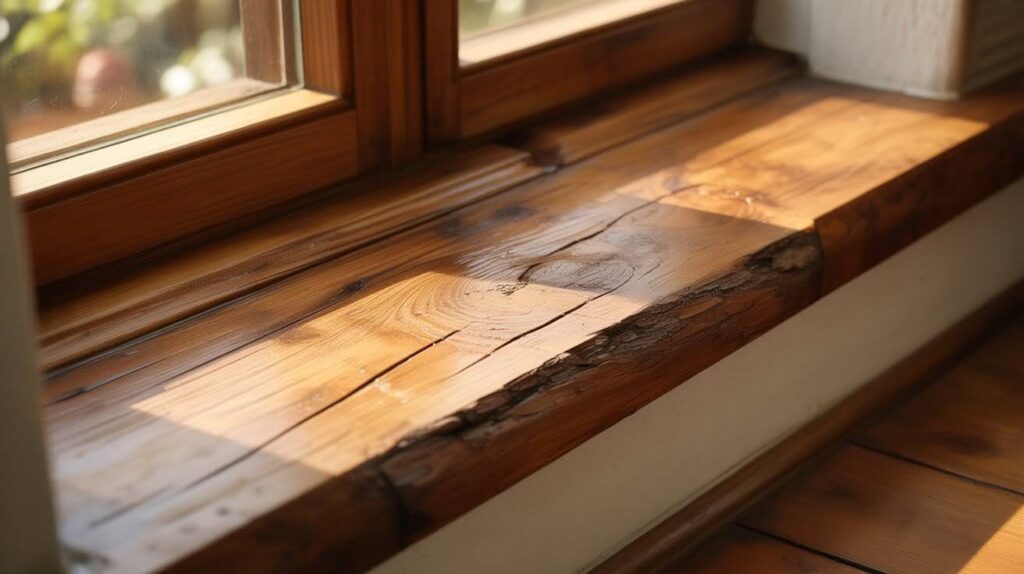
Wood brings warmth and traditional beauty. Many older homes feature wooden sills that have lasted for generations. You can stain or paint wood any color, and the grain patterns add natural texture.
Cedar and redwood resist moisture better than pine. Hardwoods like oak last longer but cost more. Wood looks beautiful and you can repair damaged sections easily.
But wood needs regular sealing against moisture. It can rot, warp, or attract termites. Paint peels over time and needs repainting. Wood works best in protected areas with roof overhangs or dry climates.
Designs and Materials:
- Solid hardwood (oak, maple, mahogany)
- Softwood options (pine, cedar, redwood)
- Stained finishes to show grain
- Painted finishes in any color
- Beveled edge profiles for water runoff
- Flat sill profiles for modern looks
2. Stone Window Sills

Stone offers timeless beauty and incredible durability. It handles any weather and ages gracefully. Stone sills resist water, heat, and cold naturally, with colors that stay true for decades.
Granite ranks as the most popular choice. It’s hard, weather-resistant, and available in many colors. Gray, black, and tan granite fit most home styles. Marble looks luxurious but costs more and scratches easier.
Stone needs occasional cleaning and resealing. Most types last 50 years or more without replacement. Initial costs run high, but you won’t pay again. Installation requires professional help due to the weight.
Designs and Materials:
- Polished granite for shine
- Textured stone for grip
- Honed marble for elegance
- Custom edge designs (bullnose, beveled, squared)
- Natural-cut stone slabs
- Limestone for traditional homes
- Slate for contemporary style
3. Aluminum Window Sills

Aluminum combines light weight with serious durability. It won’t rust and handles rough weather easily. Aluminum sheds water naturally and doesn’t rot, crack, or support mold growth.
The light weight makes installation simple. Powder-coating provides lasting color options like white, bronze, and black. Custom colors match any home palette.
Modern aluminum sills include insulation layers that reduce rain noise. A quick wipe-down keeps them clean. No painting or sealing required, and they resist corrosion in coastal areas better than steel.
Designs and Materials:
- Powder-coated aluminum in any color
- Anodized finishes for extra protection
- Sleek modern profiles
- Drip-edge designs for water control
- Insulated core options
- Brushed aluminum texture
- Mill finish for industrial look
4. PVC (Plastic) Window Sills

PVC delivers great value and requires almost no maintenance. It resists moisture perfectly and costs less than most alternatives. Water runs right off without causing damage.
Installation is fast and simple. PVC weighs little and cuts easily. Today’s PVC comes textured to look like wood grain or stone in colors like white, tan, gray, and woodtones.
Close inspection reveals it’s plastic, but from a distance, it looks convincing.
Designs and Materials:
- Hollow-core PVC for affordability
- Solid PVC for strength
- Textured wood-grain surface
- Smooth glossy finishes
- Embossed stone patterns
- UV-resistant formulations
- Cellular PVC for insulation
5. Tile Window Sills

Tile adds decorative flair and comes in countless patterns. It’s most common indoors but works outside too. Ceramic or porcelain tiles create custom looks, and glazed tiles shine beautifully.
Tiles suit Mediterranean and Spanish home styles especially well. A damp cloth keeps tiles spotless, though grout lines need occasional scrubbing.
Outdoor use risks cracking in freezing weather. Grout can crack and let water through. Installation takes skill to ensure proper slope and waterproofing.
Designs and Materials:
- Ceramic tiles in all colors
- Porcelain for durability
- Mosaic tile patterns
- Matte finishes for texture
- Glossy finishes for shine
- Hand-painted tiles for custom looks
- Large format tiles for modern style
6. Concrete Window Sills
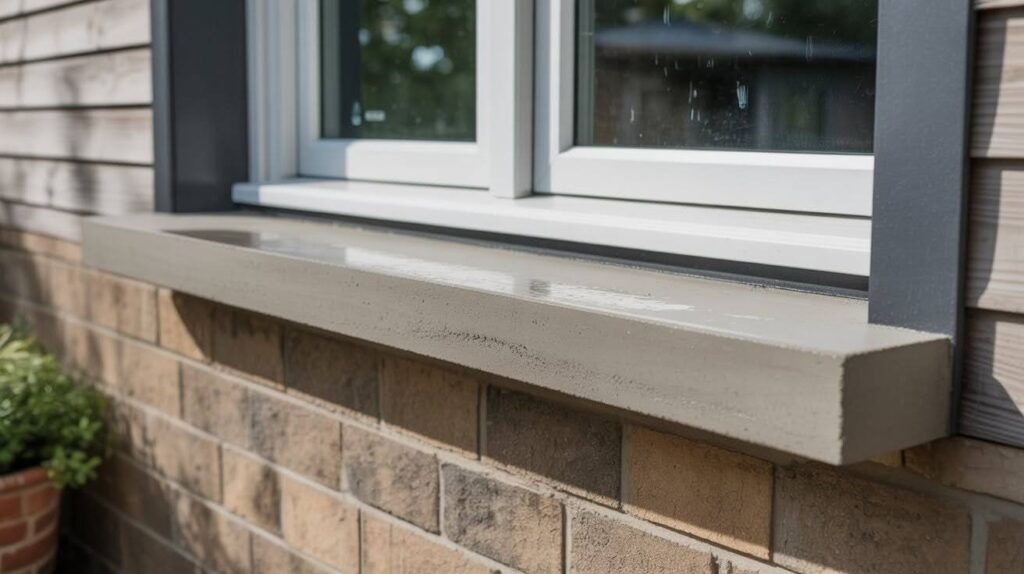
Concrete provides industrial strength at reasonable cost. It handles extreme weather without complaint. Poured or precast concrete lasts decades and won’t rot, rust, or fade.
Weather and UV rays barely affect it. Modern concrete sills come pre-made in standard sizes, or you can custom pour any shape you need.
Plain concrete looks utilitarian, but paint or stain changes the appearance completely. You can stamp patterns into wet concrete or add aggregate for color variation.
Designs and Materials:
- Precast concrete panels
- Smooth polished finish
- Rough textured surface
- Tapered drip-edge profiles
- Painted concrete in any color
- Acid-stained concrete
- Aggregate-embedded designs
- Sloped top for drainage
7. Brick Window Sills
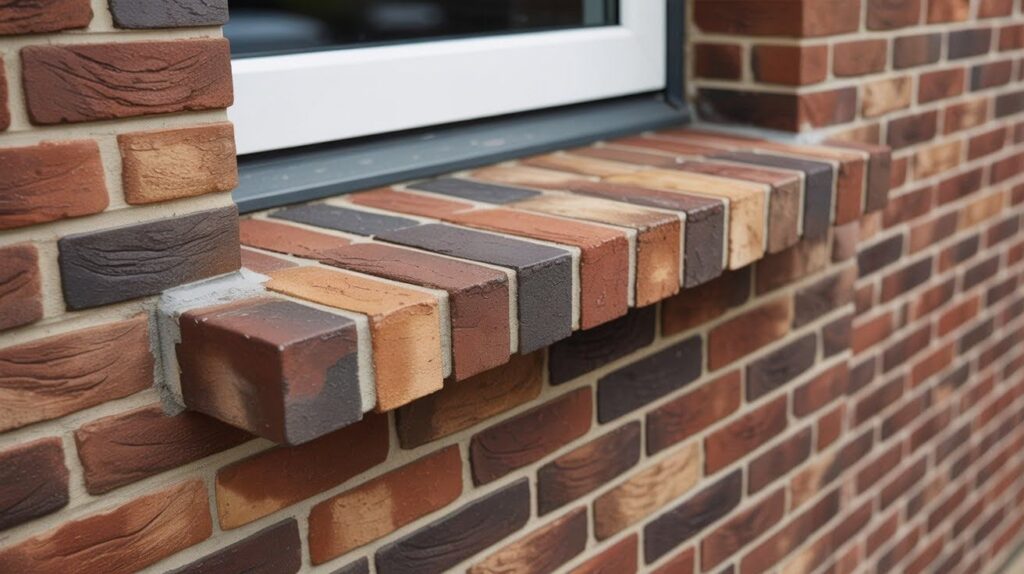
Brick matches brick homes perfectly. It creates visual flow across the entire facade. Matching your sill brick to your wall brick unifies the design with natural red, brown, or tan tones.
Baked clay bricks last as long as your home’s walls. It resists moisture and temperature swings naturally. No painting or sealing needed.
Mortar joints might need repointing after many years. Otherwise, maintenance is minimal.
Designs and Materials:
- Solid clay bricks
- Angled edge bricks for water runoff
- Rowlock brick patterns
- Mortar-set designs
- Soldier course arrangements
- Decorative brick headers
- Matching or contrasting brick colors
8. Composite Window Sills
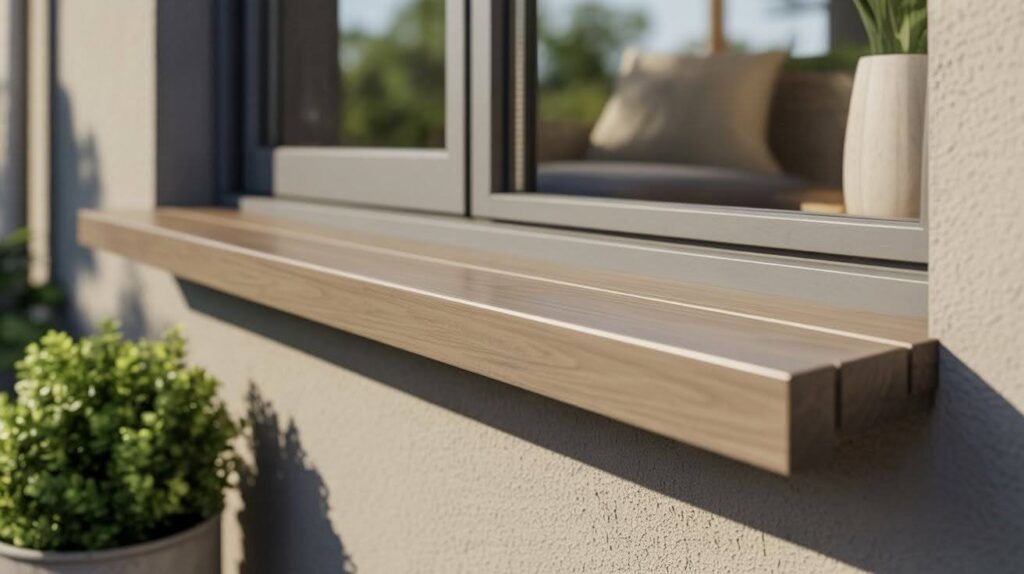
Composite materials blend wood fibers with plastic resins. You get wood’s look with plastic’s durability. Composites resist moisture better than solid wood and won’t rot or attract insects.
The density provides good insulation value. This helps reduce energy costs slightly. Many composites use recycled materials, keeping plastic out of landfills.
Composites accept stain and paint like wood. You can change the color when you want a fresh look.
Designs and Materials:
- Wood-plastic composite (WPC) blends
- Fiber-reinforced composite
- Customizable colors
- Wood-grain textures
- Smooth painted finishes
- Hollow or solid core options
- Capped composite for extra protection
9. Vinyl Window Sills

Vinyl offers the lowest maintenance and great energy efficiency. It suits any climate and costs less than wood, stone, or metal. Hollow chambers inside provide insulation that reduces heat transfer.
White vinyl reflects heat in summer. Darker colors absorb warmth in winter. Salt air and humidity don’t harm vinyl. Rain and snow slide right off.
Vinyl expands and contracts slightly with temperature changes. Proper installation accounts for this movement.
Designs and Materials:
- Solid vinyl construction
- Insulated vinyl cores with air chambers
- Smooth vinyl finishes
- Textured vinyl surfaces
- White and color options
- UV-stabilized vinyl
- Co-extruded vinyl for durability
10. Stainless Steel Window Sills
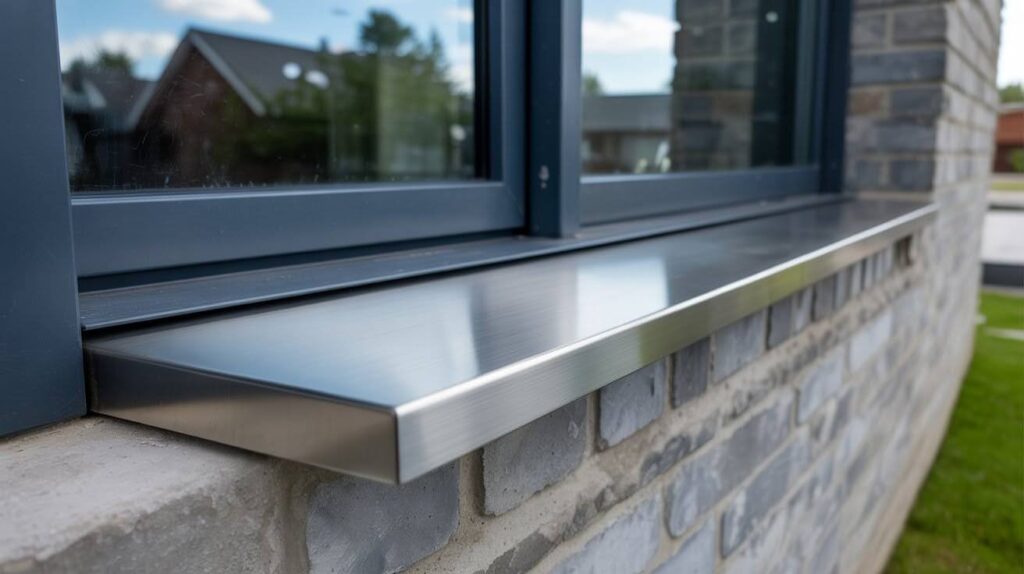
Stainless steel brings modern style and ultimate corrosion resistance. It suits contemporary homes perfectly. Brushed stainless looks industrial and clean, catching light in interesting ways.
Nothing corrodes stainless steel. It works beautifully with glass, concrete, and other modern materials. Minimalist designs benefit from stainless steel’s simple lines.
The cost runs high compared to aluminum. Installation requires metal-working skills for custom fits.
Designs and Materials:
- Brushed stainless steel finish
- Polished steel for mirrors shine
- Minimalist angular profiles
- Rounded edge profiles
- Integrated drip edges
- Various steel grades (304, 316)
- Custom fabricated shapes
11. Fiberglass Window Sills
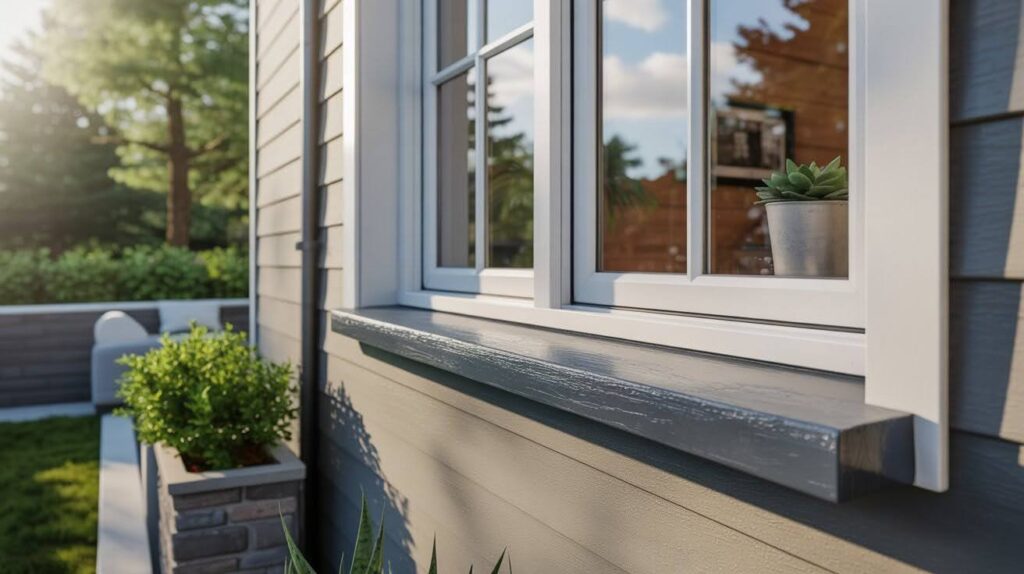
Fiberglass combines strength, light weight, and energy efficiency. It’s gaining popularity for good reasons. Pound for pound, fiberglass is stronger than steel and won’t rot, rust, or corrode.
Temperature extremes don’t affect it. The material insulates better than metal or stone, helping control energy costs. Fiberglass needs no painting or sealing.
Colors go all the way through the material, so scratches barely show. Expect 30-plus years of service with minimal care.
Designs and Materials:
- Molded fiberglass panels
- Integrated color-through material
- Reinforced sill edges
- Smooth gel-coat finishes
- Textured surfaces
- Custom color matching
- Pultruded fiberglass profiles
- UV-resistant formulations
How to Choose the Right Exterior Window Sill
Your decision comes down to three main factors. Balance them based on your priorities.
Consider Function, Durability, and Budget:
Start with your budget range. This eliminates some options immediately. Then think about durability needs based on your climate.
Match function to your situation. Heavy rain demands water-resistant materials. Freezing winters need crack-resistant options.
Compare lifespan versus cost. Spending more now might save money over 20 years.
Match the Material to Your Home’s Climate and Design:
Hot, dry climates handle any material well. Wet regions need materials that shed water fast. Coastal areas require corrosion resistance.
Your home’s style guides material choice too. Modern homes suit metal and concrete. Traditional designs want wood or stone.
The sill should look like it belongs. When you can’t decide between options, choose the more durable one.
Maintenance Tips for Exterior Window Sills
Proper care extends sill life by years. Simple steps prevent major problems.
- Clean sills twice yearly with mild soap and water to remove dirt and debris that trap moisture.
- Reseal wood sills every two to three years and stone sills every five years for lasting protection.
- Inspect caulk joints where the sill meets the window frame and replace cracked or missing caulk immediately.
- Ensure proper drainage so water runs off quickly instead of pooling on the sill surface.
- Check for cracks or gaps where water might enter and fill small cracks right away before they grow.
- Watch for mold or mildew growth in humid areas and clean it fast with appropriate cleaners.
- Trim plants and vines away from sills to prevent moisture buildup and allow proper airflow.
Conclusion
Choosing from the types of exterior window sills can feel overwhelming at first. I remember standing in a hardware store myself, unsure which material would work best.
But once you understand your climate and style needs, the choice becomes clear. Wood, stone, vinyl, or metal – each has its place.
Take your time comparing options. A quality sill protects your investment for years to come.
Ready to get started? Reach out to a local contractor for professional guidance, or drop a comment below sharing which sill type caught your eye.
Frequently Asked Questions
What is the most durable exterior window sill material?
Stone like granite offers the longest lifespan with minimal upkeep. Stainless steel and concrete also last decades in harsh conditions.
Can I install exterior window sills myself?
Lightweight materials like PVC and vinyl work for DIY projects. Stone and concrete need professional installation for safety and proper waterproofing.
How often should I replace exterior window sills?
Quality sills last 20 to 50 years with good care. Replace them when you see cracks, rot, or water damage affecting your windows.
Which window sill material works best in rainy climates?
PVC, vinyl, aluminum, and stone handle moisture best. Avoid wood in wet areas unless your windows have large protective overhangs.
Do exterior window sills affect home energy efficiency?
Yes, insulated sills reduce heat loss through windows. Vinyl, fiberglass, and composite materials perform better than metal or stone for energy savings.

